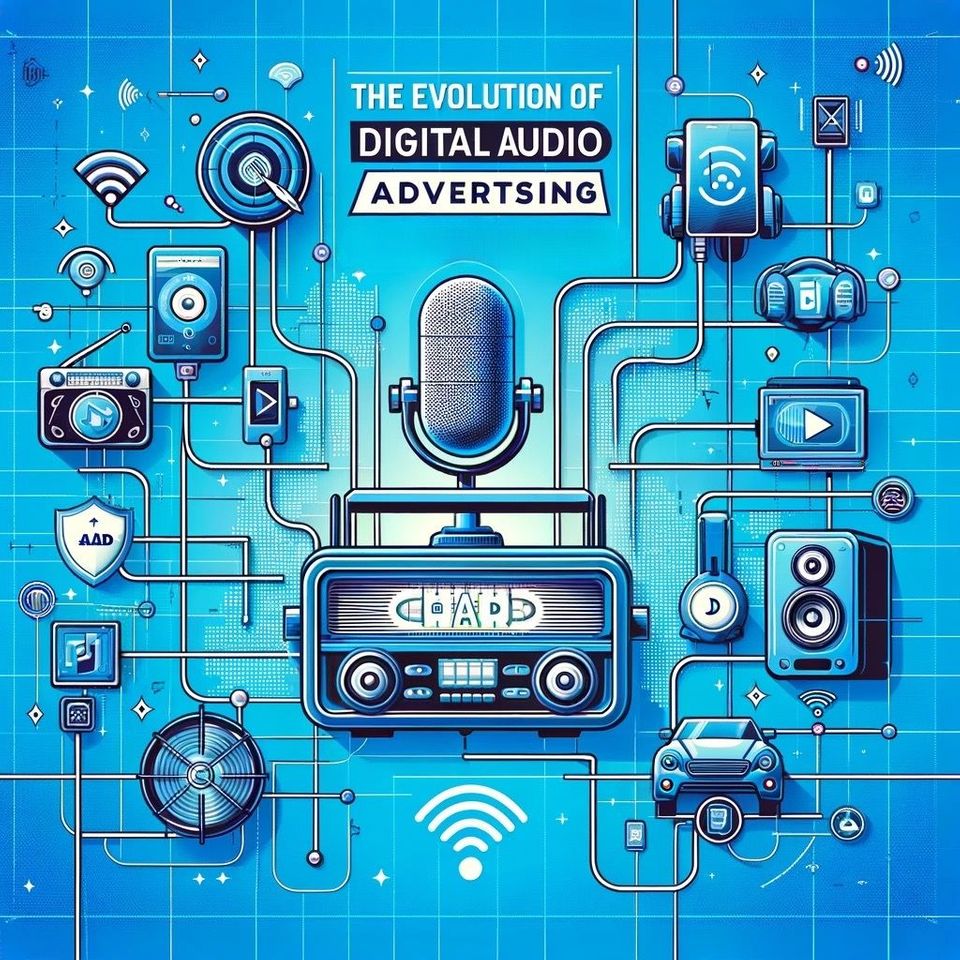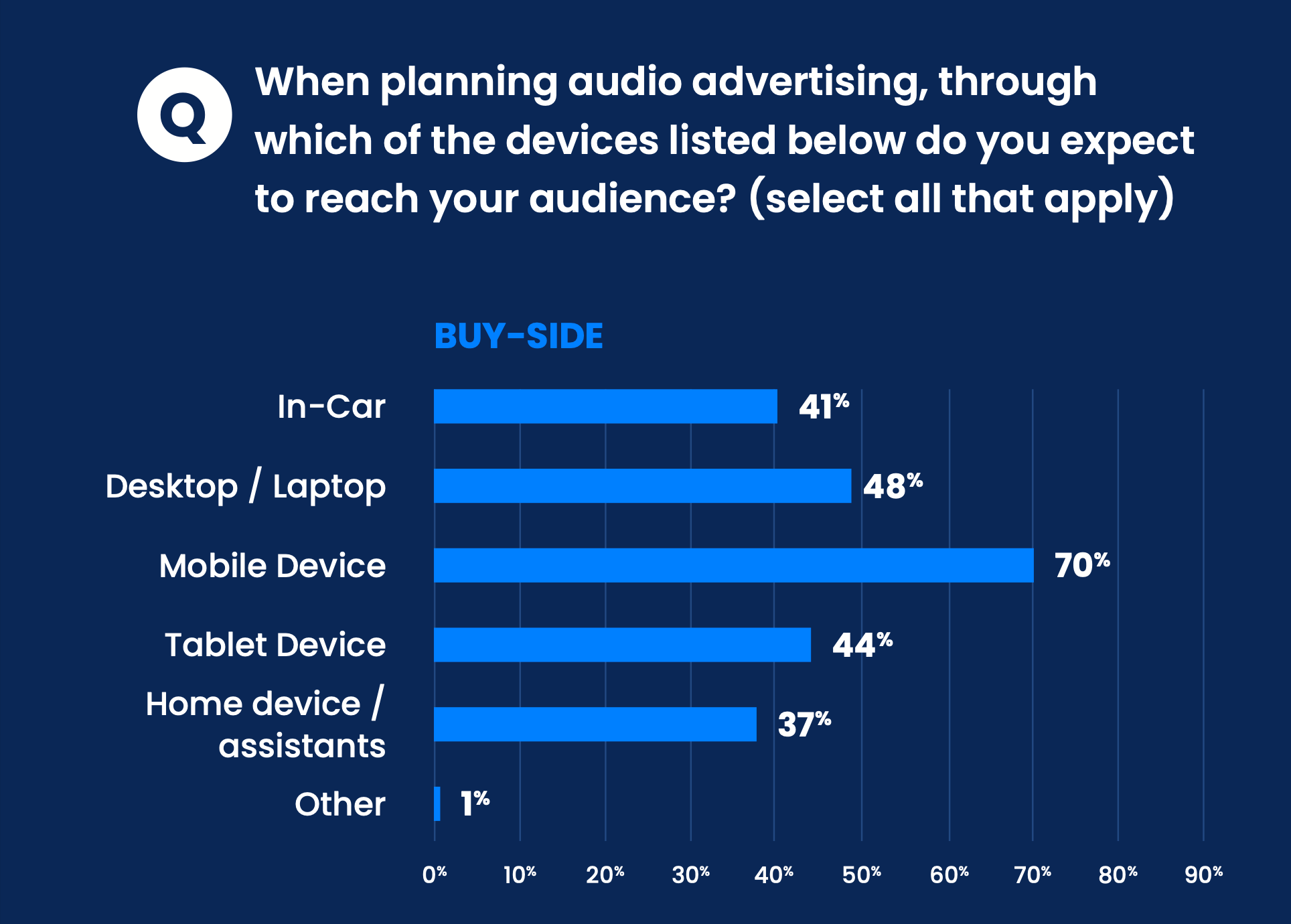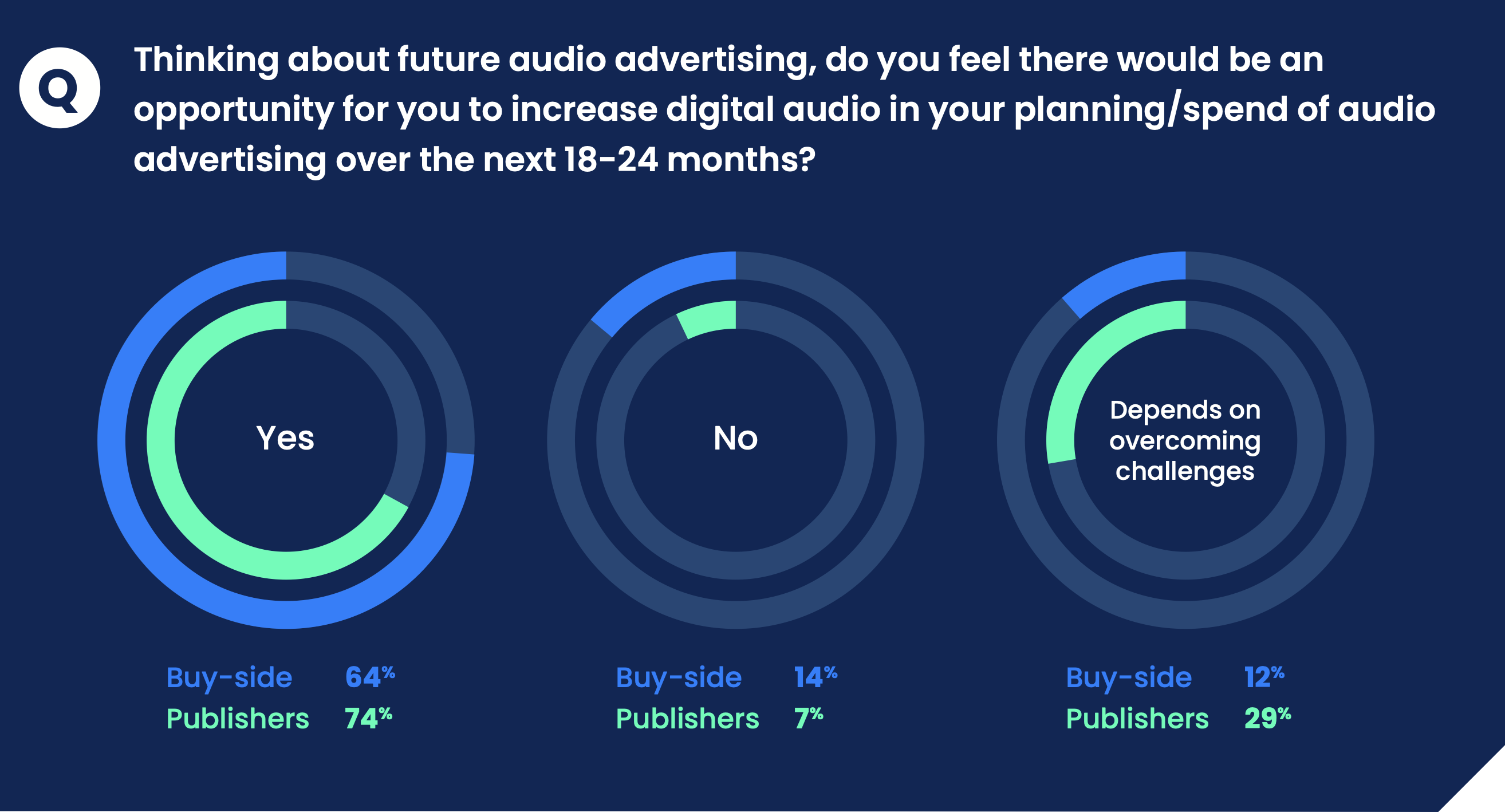The Evolution of Digital Audio Advertising in Europe: Insights, Trends, and Future Directions - 2024 survey.

Audio advertising stands out as a dynamic and increasingly influential medium. As we navigate through the intricacies of digital audio advertising in Europe, this article offers a comprehensive overview of its current state, examining investment levels, technological advancements, and consumer engagement.
We also explore the trends shaping the future of audio advertising, from the rise of mobile and interactive platforms to the challenges and opportunities that lie ahead. This in-depth analysis aims to provide marketers, advertisers, and media professionals with essential insights into the fast-paced world of digital audio advertising, highlighting its significance in the ever-changing digital media landscape.
Table of contents:
1. Introduction
2. Early Beginnings and Recent Growth of Digital audio advertising
3. Current Trends in Digital Audio Advertising
4. Barriers and Opportunities of Digital audio advertising
5. The Future of Digital Audio Advertising
6. Conclusion
Introduction
Digital audio advertising in Europe stands as a shining example of innovation and growth. The ability of digital audio to connect brands with potential customers through engaging brand messages is unparalleled.
With the rise of mobile devices and smart speakers, the reach of digital audio content extends further, making it a powerful medium to reach listeners across various demographics. The rise in podcast listeners and internet users tuning into streaming services has revolutionized the way advertisers approach audio formats.
Digital audio offers, including dynamic ad insertion in podcast ads and tailored messages in digital radio, are reshaping how businesses connect with their audiences. Streaming platforms have become pivotal in this transformation, offering marketers a new avenue to convey their brand messages effectively and measure brand metrics with greater accuracy.
As per the recent report by IAB Europe, key drivers of this burgeoning sector include the ability of digital audio ads to seamlessly integrate into the diverse listening habits of European audiences. Campaigns that leverage the unique nature of podcast content or the widespread appeal of streaming can reach audiences with unprecedented precision.
This article takes a comprehensive look at the trends, demand, and growth in the digital audio market, offering valuable insights for marketers, advertisers, and companies looking to capitalize on the benefits of this dynamic platform.
Methodology and Participants
Methodology centered around an extensive survey that reached out to a diverse group of 549 stakeholders across 29 European markets. Conducted between May and June 2023, this survey tapped into the national IAB network in Europe, garnering valuable insights from a balanced mix of advertisers (30%), agencies (50%), and publishers/media owners (20%).

This diverse participant pool offered a multi-faceted view of the digital audio advertising sector, reflecting the varied experiences and perspectives within the industry. Intriguingly, the survey revealed that a significant 54% of respondents spend more time listening to digital audio content than other media channels, with 24% dedicating about the same amount of time, and only 22% listening less.
This data not only underscores the rising prominence of digital audio in the media landscape but also provides a crucial context for understanding the current state and potential future of digital audio advertising in Europe.
Early Beginnings and Recent Growth of Digital audio advertising
The journey of digital audio advertising in Europe is one marked by steady ascent and promising potential.
As elucidated in GroupM's 2023 Global Mid-Year Forecast, the digital audio advertising sector experienced a notable 19.4% growth in 2022, a testament to its burgeoning significance in the digital realm. Countries such as Ireland, Belgium, Germany, and Spain are at the forefront of this trend, allocating a significant part of their digital advertising expenditure to audio platforms.
This growth narrative is further echoed in the investment patterns observed among advertisers. According to survey data, 73% of buy-side respondents allocated 1-25% of their total advertising budget to digital audio, with a noteworthy 24% investing between 11-25%, highlighting the nascent yet expanding role of digital audio in overall advertising strategies.
On the publisher's side, the trend mirrors a similar trajectory. About 66% reported that digital audio ads constituted just 1-25% of their total advertising revenue.
However, the sector's growth potential is underscored by the fact that, since 2019, the percentage of buy-side respondents investing more than 50% of their ad budgets in digital audio has doubled from 4% to 8% in 2023. This uptick signals not only the increasing appeal of digital audio advertising but also its evolving role as a significant player in the broader media and advertising landscape of Europe.

Current Trends in Digital Audio Advertising
Several key trends are shaping the way brands connect with their audience. A deep dive into the current market reveals a significant shift towards digital audio ads, with advertisers increasingly recognizing the benefits of this medium in their overall media mix.
Investment in online audio advertising is on the rise, as demonstrated by GroupM Nexus reports, with a notable portion of marketing budgets being allocated to audio ads. The use of smart speakers and streaming services has skyrocketed, driven by consumer demand for music streaming and podcasts, thereby opening new channels for audio ad campaigns. This shift is not just about reaching listeners but also about engaging them effectively, with advertisers focusing on creating compelling audio content that resonates with their audience.
Mobile devices have become a primary tool for delivering digital audio ads, as they allow advertisers to reach listeners wherever they are, be it through radio, podcasts, or streaming platforms.

The integration of audio ads into these platforms has proven to be effective in driving brand awareness and sales. Advertisers are also exploring dynamic ad insertion in podcasts, offering a tailored listening experience to the audience and maximizing campaign impact. This trend is reinforced by increasing market demand for personalized and contextually relevant advertising experiences, making digital audio a lucrative avenue for reaching and engaging with customers.
As the digital audio advertising sector continues to grow, it is reshaping how brands think about their advertising strategies, offering new opportunities to connect with users and drive revenue in innovative and impactful ways.
Barriers and Opportunities of Digital audio advertising
The realm of digital audio advertising is marked by a complex interplay of barriers and opportunities that shape its evolution.
One of the most significant challenges identified by stakeholders is the skill gap, particularly in technical and operational areas, which impedes further investment and growth in this sector. The lack of proficiency in understanding and deploying advanced audio ad technologies, along with challenges in measuring the impact and effectiveness of campaigns, especially in the podcast domain, has been highlighted as a key hurdle. These challenges are compounded by concerns over brand safety, fraud, and transparency, further complicating the landscape for advertisers and publishers alike.
On the flip side, the opportunities within digital audio advertising are vast and promising. Interactive and dynamic audio ads are emerging as powerful tools for growth, as they offer innovative ways to engage listeners.
According to survey findings, the top drivers for investing in digital audio include its ability to complement the media mix (65%), raise brand awareness (55%), and reach specific audiences (48%), underlining its critical role in omnichannel advertising strategies.

Notably, digital audio is increasingly seen as a cost-efficient alternative to traditional TV advertising, with a particular appeal for reaching younger audiences. Publishers, facing their own set of challenges, point out the need for more accessible technology and clearer understanding of digital audio ads' impact on overall revenue, along with the cost implications of these technologies. In essence, while digital audio advertising presents a fertile ground for innovation and engagement, navigating its challenges remains key to unlocking its full potential for brands and marketers.
The Future of Digital Audio Advertising
The future of digital audio advertising is poised for significant expansion, buoyed by a wave of optimism and strategic foresight from industry stakeholders.

A resounding 74% of buyers and 64% of publishers are looking ahead to increased investment in digital audio within the next 18-24 months, signaling a robust confidence in the medium's potential.
This positive outlook is further bolstered by the anticipation of growth in specific areas: interactive smart-speaker ads and dynamic audio ads are identified as the most promising frontiers for future development. The enthusiasm is shared equally among buyers and publishers, with two-thirds (66%) of buyers planning to ramp up their spending in the next 12 months, and a similar sentiment echoed by 75% of publishers expecting a rise in digital audio advertising revenues.
Looking at the longer-term horizon, the consensus among industry players is one of growth and innovation. The buy-side is particularly excited about the prospects of leveraging omnichannel insights, activation technology, and advanced contextual targeting to enhance their digital audio strategies.
On the other hand, publishers are focusing on amplifying the volume and variety of audio ads, optimizing supply chains, and promoting the creation of more engaging audio content. Both groups underscore the importance of addressing supply consolidation, industry standards, and technological innovation as the primary drivers for sustainable growth in digital audio advertising.
This comprehensive approach, encompassing both the creative and technical aspects of digital audio, lays a solid foundation for the sector's future, promising not only increased revenue streams but also a richer, more engaging audio advertising experience for audiences worldwide.
Conclusion
In conclusion, The Evolution of Digital Audio Advertising in Europe presents a vivid portrayal of an industry at the cusp of transformation. From the early days marked by steady growth and exploration to the current landscape bustling with innovative strategies and technological advancements, digital audio advertising stands as a testament to the dynamic nature of the European media and marketing sphere.
The insights gleaned from IAB Europe and GroupM’s surveys reflect a sector ripe with opportunities, despite facing challenges such as skill gaps and measurement complexities.
Looking ahead, the industry is set to witness substantial growth, driven by interactive and dynamic advertising formats, and a deeper understanding of the omnichannel advertising landscape. With the majority of stakeholders poised to increase their investment in digital audio, the future of this medium is not just promising but also indicative of a broader shift in how advertising is perceived and implemented in the digital age.
As the digital audio advertising landscape continues to evolve, it remains a crucial and innovative platform for connecting brands with their audiences in meaningful and impactful ways.
IAB Europe and GroupM’s recent survey
